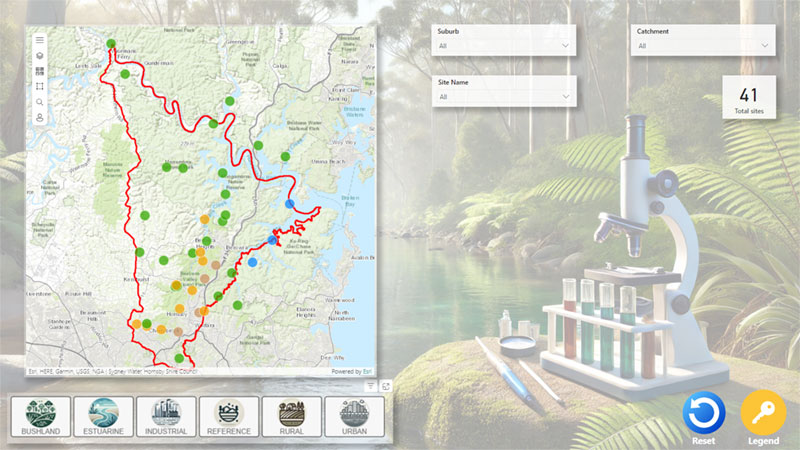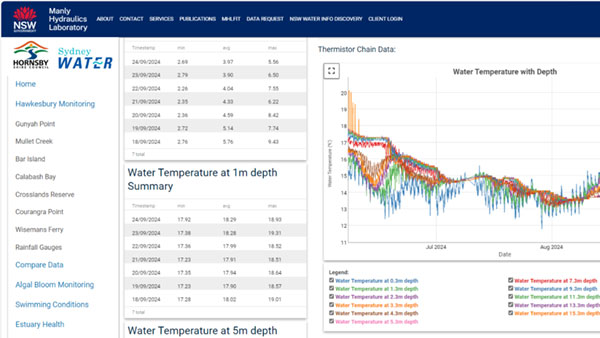Latest Catchment Health Results
Protecting our local waterways is crucial to maintaining the health of local ecosystems. To effectively manage waterways, it is important to first understand their condition and the factors influencing their health. Additionally, it is important to recognize how water quality varies both across the Shire (spatially) and over time (temporally). A robust monitoring program is key to achieving this. We have developed several tools that will help exploring our latest results.
Water Quality Data Dashboard - A, B, C, D or F
Hornsby Shire Council has been monitoring water quality since 1994, gaining valuable insights into local creeks and estuary. Over the years, our program has evolved to address specific threats to our waterways. Currently, we are running several initiatives to improve waterway health. One key initiative is the comprehensive catchment health monitoring program, which ran from 2023 to 2024. This program evaluated waterway health at 33 sites, including 6 estuarine and 27 freshwater locations across the Shire, each exposed to different threats based on land use.
To make this data easily accessible, the results have been summarised into health grades (A, B, C, D, or F) for each site, reflecting the overall health of each location. Explore the detailed site results and health grades through our interactive Water Quality Data Dashboard below.

Click on above image to view water quality dashboard
These grades follow the method outlined in the Water Quality Companion Technical Report (2012) and are based on comparisons of key indicators to locally derived environmental health guidelines (REHV). The indicators include:
- Physical and chemical water quality conditions (e.g., nutrient levels, pH, turbidity)
- Bacterial contamination
- Macroinvertebrate and benthic diatom communities, which provide a biological indication of waterway health.
- Assessment of riparian vegetation, which measures the condition of the native vegetation on riverbanks
- Assessment of creek geomorphology, which measures the quality of stream habitat and the stability of riverbanks.
HawkesburyWatch – Water Quality Intelligence Tool

Click on above image to view the Hawkesbury Watch dashboard
Our Hawkesbury Watch dashboard contains real-time information from our 7 monitoring stations deployed along the estuary. This dashboard also provides information on swimming conditions, algae monitoring and sediment quality.
Waterway Health Review – 22 Years of Data
In 2019, Council finalised a Waterway Health Review which analysed 22 years’ worth of data and provides a comprehensive understanding of the current conditions of our creek, estuary and river systems in combination with recommended management actions to protect Hornsby Shire’s highly valued local waterways into the future.
Significant Findings of the Waterway Health Review
- In general water quality at most long-term freshwater sampling sites has remained relatively stable despite an ever-growing population and increasing development pressure
- Waterways in urban areas generally have poor water quality through time
- Long-term improvements in water clarity have been achieved at many freshwater sites, however, persistently elevated nutrient concentrations, electrical conductivity and pH remain an issue
- Long-term improvements in phosphorus concentrations have been achieved at two out of three (Larool Creek, Thornleigh and Sams Creek, Mt Ku-ring-gai) monitoring sites associated with industrial land use
- Estuarine sites in the Hawkesbury River are exhibiting impacts from pressures that extend well beyond the Hornsby LGA, particularly with regards to increasing nutrient concentrations
- Most sources of faecal bacteria in both fresh and estuarine waterways are associated with pulse, or intermittent, pollution events that are likely to be rainfall related
- Significant improvements in nutrient concentrations are evident following the completion of Sydney Water upgrades to the Hornsby Heights and West Hornsby Wastewater Treatment Plants in 2003, however, no further improvements are evident since this time.







